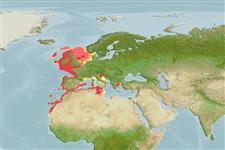Classification / Names
Common names from other countries
Main reference
Size / Weight / Age
Max length : 80.0 cm TL male/unsexed; (Ref. 3261); common length : 50.0 cm TL male/unsexed; (Ref. 3261); max. reported age: 18 years (Ref. 88187)
Length at first maturity
Lm 61.0 range ? - ? cm
Environment
Marine; demersal; depth range 8 - 530 m (Ref. 88171)
Climate / Range
Temperate, preferred 12°C (Ref. 107945); 61°N - 16°N, 18°W - 25°E
Distribution
Eastern Atlantic: Shetlands, southern North Sea and the western Baltic to Mauritania, including the western part of the Mediterranean (to Tunisia and western Greece).
Countries | FAO areas | Ecosystems | Occurrences | Introductions
Short description
Dorsal
spines
(total): 0;
Anal
spines: 0;
Anal
soft rays: 0. Sub-rhomboid in shape with a short rostrum and rounded wing-tips. Upper surface almost smooth in young, but prickly in large specimens, except for bare centers of pectoral fins and hind part of disc, underside nearly smooth; orbital thorns separate, a regular row of 20-50 usually persistent thorns from nape to first dorsal fin; with 1-2 thorns between dorsal fins; 2 equal-sized dorsal fins at end of tail. Brownish dorsally with numerous small dark spots which do not reach the margin of the disc, frequently with a concentration of dark spots forming a ring around a pale centre on hind part of each pectoral fin, underside white (Ref. 3167).
IUCN Red List Status (Ref. 115185)
Threat to humans
Harmless
Human uses
Fisheries: minor commercial
More information
ReferencesAquacultureAquaculture profileStrainsGeneticsAllele frequenciesHeritabilityDiseasesProcessingMass conversion
Tools
Special reports
Download XML
Internet sources
Estimates of some properties based on models
Phylogenetic diversity index
PD50 = 0.5000 many relatives (e.g. carps) 0.5 - 2.0 few relatives (e.g. lungfishes)
Trophic Level
3.9 ±0.2 se; Based on diet studies.
Resilience
Low, minimum population doubling time 4.5 - 14 years (K=0.18-0.21; tm=8; tmax=14; Fec=24)
Vulnerability
High vulnerability (59 of 100)
Price category
